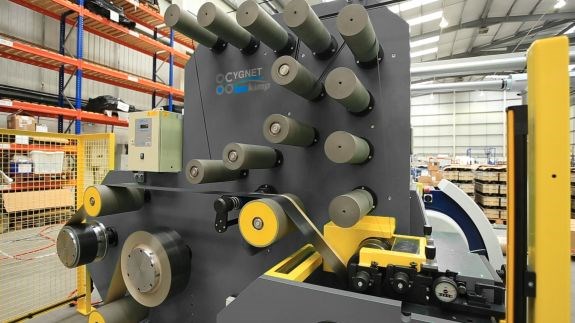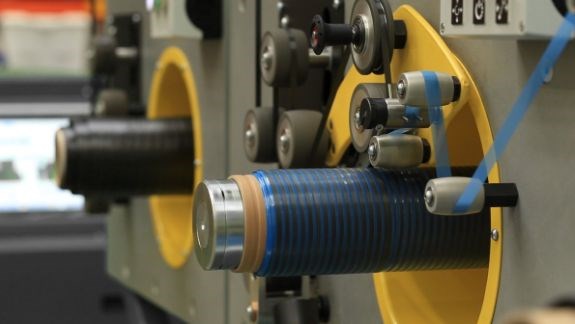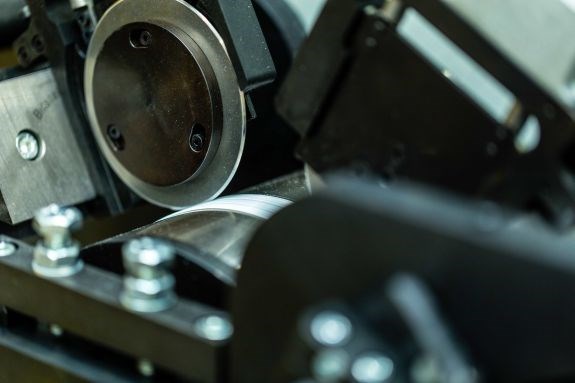Making prepreg tape more accessible
Cygnet Texkimp’s new slitter-spooler offers economical production of high-quality tapes and vertical integration for manufacturers to access a much wider market.
Prepreg materials have been used for decades in sporting goods, aircraft and wind blades. As the composites industry has sought to reduce cost and increase production rates, it has replaced hand layup with automated methods. In commercial aircraft, gantry-based automated tape laying (ATL) and now robot-based automated fiber placement have become increasingly common. But the tapes that feed these machines are typically slit from large-width prepreg rolls. Indeed, as Jeff Sloan pointed out in the preview of his CW Talks podcast with Web Industries, Boeing and Airbus cannot make a single 787 or A350 XWB (respectively) without prepreg first being slit into tapes.
Now, fiber handling and converting specialist Cygnet Texkimp has launched a slitter-spooler machine to make carbon fiber prepreg tape more accessible (scroll down to see video). The machine can create up to 48 tapes at once at a speed of up to 50 m/min. It enables prepreg manufacturers to vertically integrate the slitting process into their production lines. For manufacturers, slitting in-house can reduce the cost and time of storing and transporting prepreg in climate-controlled conditions.

Carbon fiber unwind with narrow width tape slitting.
SOURCE: Cygnet Texkimp.
Quality and economy
I asked Peter Bugeja, Cygnet Texkimp product manager for web converting, what makes this machine different from slitters already used in the industry? “One difference with this machine is the knives for slitting to 0.125-inch-widths,” he replies. “With conventional narrow width slitting units, the knives are rigid and not very flexible. Although the slitting knives are manufactured to a very high width tolerance, they can produce an accumulative error when multiple blades are stacked together. When slitting multiple tapes, this error will multiply. For example, over 48 knives the error between the top and bottom blades can reach 0.25 mm misalignment between cutting edges.” He notes this type of knife is also typically overloaded to maintain efficiency, which also reduces slitting quality. “We use spring-loaded knives for a gentler cutting force. This also produces less blade wear and a higher quality cut.”
“In addition to having a better knife setup, we have designed our own knife holder so that we can use standard cutting blades but still produce high quality slit tapes,” Bugeja continues. “The cost of these standard blades is one-fourth that of the rigid knives used by most slitting operations. So, we deliver high quality at a very economical price.”
The quality of prepreg tape is important, directly impacting the quality and production speed of the finished composite laminate. “We typically keep the sheet width to 12 inches, which still allows economical production of 0.5-, 0.25- and 0.125-inch-wide tapes,” says Bugeja. Why? “It again goes back to quality. Because of the required cant angle of the knives, the blades at the outer edges of the sheet are slightly shallower than the knives at the center of the sheet, compensated by increasing blade depth. As the sheet width increases, this impacts the blade depth. The latter is where you run into quality problems with prepreg, because if the knives are cutting in too deep, you get too much friction on the blade and issues in the cut prepreg.” In order to avoid having higher quality tapes cut from sheet edges and poorer quality tapes cut from the center, Cygnet Texkimp recommends keeping sheet width to 12 inches or less.
Cygnet Texkimp has been able to assess its slitter-spooler quality via a project with two Tier 1 aerostructures suppliers. “The rate of pulled fibers from the edges — what we call stringers — in their tapes vs. ours was 20 to 1,” says Bugeja.

Carbon fiber prepreg spooling head with poly interleaf insertion.
SOURCE: Cygnet Texkimp
Spooling and speed
Cygnet Texkimp’s slitter-spooler machine performs several functions: unwinding the master sheet, slitting that sheet into tapes and then winding the slit tapes onto spools. “We have a long history in textile and fiber handling and understand the issues involved,” says Bugeja. “If slit prepreg tapes touch each other, you will cross-contaminate the tapes, pull fibers out at the edges and create stringers. These then wrap around rollers and get into the rewind mechanism.” They also cause problems once the spools are loaded into an ATL machine. “To overcome this, we do not force the slit tapes into position with flanges, but instead use flat rollers,” he explains. “We also keep the tapes separate from slitting onward, with each wound up on their own dedicated line and spool.”
What about speed? How does 50 m/min compare with conventional slitters? “The speed we offer is comparable to what is typical in the industry now, but our focus is on quality,” says Bugeja. “We can make spoolers that operate at very high speeds, but the heat generated during cutting at such speeds will pick resin as the prepreg is slit. We would then have to stop the machine more often to clean the knife blades. Thus, it is a balance between speed and stopping the line to clean the blades.” Running slightly slower can be more productive, he asserts, but primarily depends on the product being slit. “If you have materials where there is not much resin or the prepreg is not very tacky, then you can run these much faster.

Crush cut cartridge for slitting wire-reinforced plastic tapes.
SOURCE: Cygnet Texkimp.
Modular construction
Cygnet Texkimp’s standard slitter-spooler has four tape winding heads. “But you can add up to 48 and some customers slitting down to .125-inch-wide tape have requested 96,” Bugeja observes. . “Thanks to the machine’s modular construction, you can swap out any spooling head for repair/maintenance and keep the line running. Thus, downtime is minimized. How many heads you use is a balance between which width tapes you are slitting and production requirements. For example, with a 96-head setup, if you switch away from 0.125-inch-wide tapes to produce 0.25- or 0.5-inch-wide tapes, then half the heads become redundant. The modular construction makes any of these arrangements possible, but you’ll have to decide the best configuration for your operation.”
Making tape more accessible
“Historically, the cost of manufacturing slit tape means it has tended to be used only at the highest end of the composites market, to make parts like aircraft stringers and fuselages,” says Cygnet Texkimp managing director Luke Vardy. “If you can reduce the cost of production through vertical integration, you immediately cut the on-cost to the end user, and that gives manufacturers access to a much wider market including high-volume automotive.” He notes that having the ability to convert carbon fiber prepreg onsite gives manufacturers total control over production quality and speed. “And that enhances profitability. If you can slit, spool and ship the prepreg as soon as it’s manufactured, then the whole process becomes infinitely more simple, efficient and profitable. The impact on the future of the composites industry is potentially huge.”
Cygnet Texkimp has begun selling their slitter-spooler to the composites industry worldwide. Though it will be initially used to make ATL and AFP aerospace parts, automotive and industrial markets are also being developed. Visit Cygnet Texkimp in booth H85 at CAMX 2018 (Oct 16-18, Dallas, TX, US). Cygnet Texkimp is also a sponsor of Carbon Fiber 2018 (Dec. 4-6, La Jolla, CA, US) and will be exhibiting there for companies wanting to learn more.
Related Content
Natural fiber composites: Growing to fit sustainability needs
Led by global and industry-wide sustainability goals, commercial interest in flax and hemp fiber-reinforced composites grows into higher-performance, higher-volume applications.
Read MorePlant tour: Albany Engineered Composites, Rochester, N.H., U.S.
Efficient, high-quality, well-controlled composites manufacturing at volume is the mantra for this 3D weaving specialist.
Read MoreThe potential for thermoplastic composite nacelles
Collins Aerospace draws on global team, decades of experience to demonstrate large, curved AFP and welded structures for the next generation of aircraft.
Read MoreTU Munich develops cuboidal conformable tanks using carbon fiber composites for increased hydrogen storage
Flat tank enabling standard platform for BEV and FCEV uses thermoplastic and thermoset composites, overwrapped skeleton design in pursuit of 25% more H2 storage.
Read MoreRead Next
“Structured air” TPS safeguards composite structures
Powered by an 85% air/15% pure polyimide aerogel, Blueshift’s novel material system protects structures during transient thermal events from -200°C to beyond 2400°C for rockets, battery boxes and more.
Read MorePlant tour: A&P, Cincinnati, OH
A&P has made a name for itself as a braider, but the depth and breadth of its technical aptitude comes into sharp focus with a peek behind usually closed doors.
Read MoreCFRP planing head: 50% less mass, 1.5 times faster rotation
Novel, modular design minimizes weight for high-precision cutting tools with faster production speeds.
Read More






















